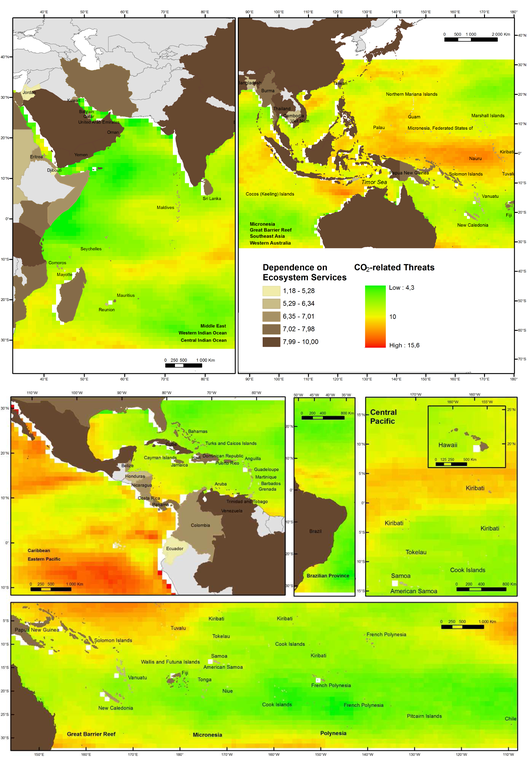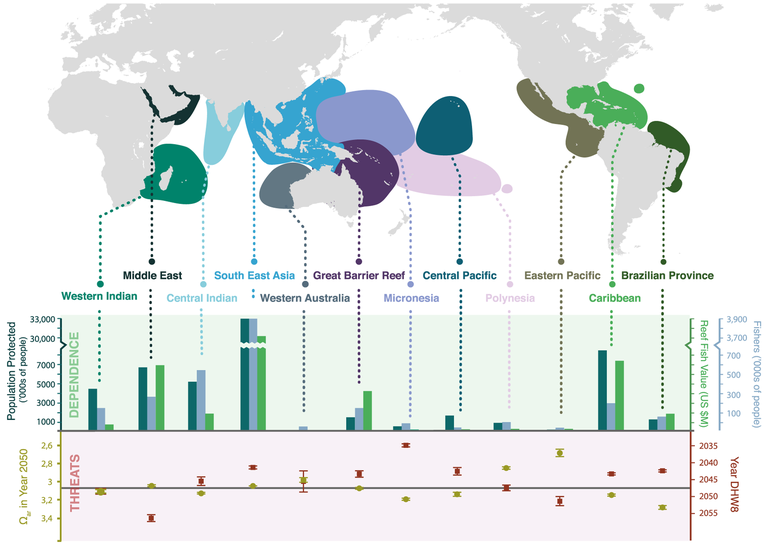Coral reefs and people in a high CO2 world: where impacts will affect people
On other pages, we described the complex relationship between coral reefs and people, we saw that coral reefs and the ecosystem services are not distributed evenly around the planet (some places are more dependent than others), and that coral reefs are threatened by two stresses directly associated with increased CO2 in the atmosphere. With these data in hand, we can draw conclusions about where people may be most affected by these changes. These are places where people need to take action now to reduce the impacts of bleaching and ocean acidification on corals. In some cases, where these threats are likely to be so severe, coastal communities are going to have to consider other forms of adaptation, including possibly moving people away from coastal areas.
The one-two punch of climate change and ocean acidification for coral reefs
Where increased sea temperatures and ocean acidification combine, corals will be most at risk. We created a combined indicator of risks from elevated sea temperature and ocean acidification to identify places in the world where coral reefs are the most at risk from CO2-related threats. The results are shown on the map below (Fig 1), where red colors indicate a high risk. Two conclusions can be drawn:
- Combined risks from climate-related stress will mostly be in the Western and Eastern Tropical Pacific.
- There is no place where coral reef areas are completely free from both global stressors. In other words, there are no perfect coral reef refuges from the impacts of climate change and ocean acidification.
Additionally, we need to know where these high environmental threat put people at risk. Using maps of human dependence on coral reefs, we can see how these combined threats align with high human dependence. Northwestern Australia, southern Indonesia, parts of the Coral Triangle, and Western Mexico all have high human dependence and face serious CO2-related threats.

Fig 1. Country-level dependence on coral reef ecosystem services and future combined normalized scores (2-20) for CO2-related threats (e.g. ocean acidification and thermal stress). Ocean Provinces are indicated in each panel in bold. Higher scores indicate higher dependence and higher ecological risk.
Where do we need more science?
Certain regions of the world are in particular need of more and better science if coastal managers are going to take action to reduce the human impacts associated with a high CO2 world. Figure 2 summarizes, at a regional level, the threats to coral reef in a high-CO2 world as well as the regional dependence on reef ecosystem services. The figure shows:
- The Threats panel (bottom) indicates that ocean acidification (omega aragonite levels) and bleaching due to thermal stress (8 DHW) will be above average risk for Southeast Asia.
- The Dependance panel (middle) shows that Southeast Asia has, by far, the greatest overall dependance on coral reef ecosystem services (as measured by (i) total number of people in the region who live at low elevations that are protected by reefs, (ii) number of fishers, and (iii) value of fisheries).
Overall, our analysis shows that in a high CO2 world, Southeast Asia stands out as the place where coral reefs are the most at risk and and where people are the most dependent on the ecosystem services they provide:

Fig 2. Regional dependence, by ocean province, on ecosystem services and average CO2-related threats (ocean acidification measured as projected Ωar levels at coral reefs in 2050 and elevated sea surface temperature as measured by year that 8 DHW are projected to occur annually).
The horizontal line in the threats panel represents the mean threat for all regions (scores above this line indicate above average severity of threat). The scales for the reef fish dependence scores are broken to reduce the size of the graph. Note that the Great Barrier Reef Ocean Province includes, but is not limited to, the Great Barrier Reef.
